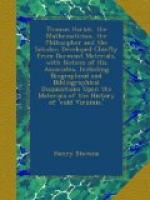At what precise time Hariot, who never deserted Raleigh, became acquainted with Henry Percy, Earl of Northumberland, with whose honored name, next to that of Sir Walter’s, his must ever be associated, does not as yet appear. It is known, however, that there was an intimacy between Raleigh and Percy as early as 1586, when Sir Walter presented Percy with a coat of mail on his going over to Flanders, and soon after a bedstead made of cedar from Virginia ; while the Earl about the same time gave to Sir Walter a ’ stroe coloured velvet saddle.’ From this time to the day of Raleigh’s triumph on the scaffold there exists plenty of evidence of their continued intimacy.
When therefore the Earl and Raleigh were finally caged together in the Tower for life in 1606 their friendship was of more than twenty years’ standing. From this we infer that Hariot also knew Percy almost from the time of his joining Raleigh; but the earliest mention of his name in connection with that of the Earl which we have met with is this of 1596, in the Earl’s pay-rolls, still preserved at Sion, and described in the Sixth Report of the Royal Commission of Historical Manuscripts, page 227, ‘To Mr. Herytt for a book of the Turk’s pictures, 7s.’ It appears from the same rolls that from Michaelmas 1597 to 1610, if not earlier and later, an annual pension of £80 (not £ 120, or £ 150, £300, as variously stated) was paid to Hariot by the Earl. This pension was probably continued as long as Hariot lived; and besides there are not wanting many marks of the Earl’s liberality, friendship, and love for his companion and pensioner, who was long known as ’ Hariot of Sion on Thames,’ as expressed on his monument. In the Earl’s accounts for 1608 there is this entry, ’ Payment for repairing and finishing Mr Heriotts house at Sion.’
At what time exactly Hariot took up his residence at Sion the Earl’s new seat (purchased of James in 1604) is not known, but probably soon after the Earl was sent to the Tower in 1606. There is preserved a Letter from Sir William Lower addressed to Hariot at Sion dated the 3Oth of September 1607, and other letters or papers exist showing his continued residence there until near the time of his death in 1621. Wood and many subsequent writers to the present time




